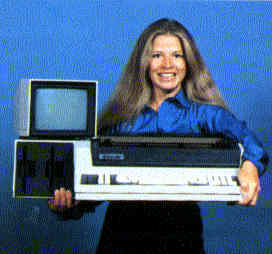| The Durango was built by Durango Systems in San Jose, CA. It is using an Intel 8085 CPU, running at 5 MHz. It came with 64K memory as standard and could be expanded to 128K in the multi-user version. |
| The F-85 was marketed as a portable computer. Well, this little girl was probably a member of the US weight-lifting team in the 1983 world championships. |  |
The Durango is running a proprietary operating system, DX-85, as well as CPM. DX-85 has multi-user extensions and the business applications are supported by a proprietary ISAM handler that has some limited multi-user extensions. The F-85 can be run with one user at the 'console' and 4 users hooked up via dumb terminals on serial connections. These users can run programs in their allocated memory space on the F-85 and have full access to the storage media and the printer. Some interprocess communications are available.
And now some data:
| Diskette capacity |
1.892 Mb |
|
Transfer rate |
38 K/sec |
|
Display size |
9 inch |
|
Printer |
9 pin serial matrix |
|
Hard disk capacity |
7-14 Mb |
|
Number of HD |
Max 2 |
|
Boot unit |
Diskette #1 |
|
Video |
24 x 80 chars |
|
Comms |
Sync/Async |
|
Print speed |
Max 200 CPS |
I had the pleasure of working on a project to get the F-85 printer output accepted by the Swedish Postal Systems OCR readers. I managed to program an OCR font that was accepted. This was the first ever matrix printer output that passed the Postal Systems acceptance tests. I should probably be proud of that, but the font was never put into production. I also worked on the "Swedishfication" of the original US Small Business Application Program Suite. I handled the Accounts Receivable modules, but also did extensive modifications to the Invoicing system. It was interesting to see that the US designed system only allowed for a sales tax less than 9.9%, while Sweden is using a multitiered sales tax with rates up to 25%. Interesting modifications indeed.
![]()
Last updated 2009-04-16 19:54:36 -0700